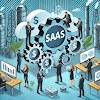The Origins and Evolution of SaaS
Early Concepts of SaaS Dating Back to the 1960s
Examining the Evolving SaaS Industry: Trends, Market Growth, and Technological Advancements in 2024
The software-as-a-service (SaaS) industry has seen rapid evolution since its inception. As businesses continue to embrace digital transformation, the SaaS model has become integral in providing scalable, accessible, and efficient software solutions. In 2024, this trend persists with remarkable growth rates, advancements in artificial intelligence (AI), and an increased emphasis on customer success and cybersecurity.
Analyzing SaaS Market Growth and Projections
The SaaS market's growth trajectory in 2024 reflects its ongoing significance in the business technology landscape. According to industry reports, the B2B SaaS market is projected to grow at an 11% compound annual growth rate (CAGR), while the B2C market is expected to experience an 8% CAGR. By the end of 2024, SaaS expenditure is anticipated to increase by 17.7%, amounting to a total of $232 billion. This substantial growth can be attributed to the rising demand for cloud-based solutions, driven by the necessity for businesses to enhance their operational efficiencies and adapt to hybrid work environments.
Looking further ahead, the global SaaS market is predicted to reach a staggering $908.21 billion by 2030, growing at a CAGR of 18.7%. This expansive growth underscores the critical role SaaS plays in fostering innovation and supporting business agility. A key milestone is anticipated in 2025, where SaaS will power 85% of all business applications, a significant increase from 70% in 2023.
Integrating Advanced Technologies: AI and Machine Learning
One of the most transformative trends in the SaaS industry for 2024 is the integration of AI and machine learning (ML). These technologies are revolutionizing how businesses interact with and utilize SaaS platforms. AI-powered solutions enhance operational efficiency, automate routine tasks, and deliver personalized user experiences. Tools like generative AI are being incorporated into SaaS solutions to transform the industry further.
For instance, AI-powered chatbots and conversational AI tools are becoming prevalent in customer service, offering 24/7 support and improving overall user satisfaction. A notable example is HubSpot's lead-generation chatbot, which leverages AI to provide personalized interactions with potential customers. Additionally, AI-assisted shopping tools utilize advanced algorithms to analyze consumer preferences and offer tailored product recommendations, significantly enhancing the retail experience.
Personalizing Customer Experiences
As competition within the SaaS market intensifies, providing personalized experiences has become paramount. Companies like Zendesk emphasize the importance of customer-centric models, where approximately 90% of customers are willing to spend more with companies that offer bespoke experiences. Personalized SaaS solutions leverage data-driven customization, AI, and ML algorithms to predict user behavior and tailor interfaces and recommendations to individual preferences.
This shift towards personalization is not merely about addressing customers by their names in emails but creating user experiences that resonate on a deeper level. Integrating omnichannel and multichannel support ensures consistency across all touchpoints of the customer journey, enhancing satisfaction and fostering loyalty.
Focus on Customer Success
In 2024, customer success continues to be a top priority for SaaS companies, with over 72% of businesses claiming it as their main focus. The global customer success platform market is projected to reach $31 billion by 2026, highlighting the growing importance of ensuring customers achieve their desired outcomes. Customer success strategies involve proactively identifying and addressing customer needs and pain points, ultimately driving retention and revenue growth.
Philipp Wolf, Founder and CEO of Custify, emphasizes the significance of personalized customer success programs. By analyzing data and user behavior, platforms like Custify enable companies to connect with their clients on a personal level, crafting experiences that boost satisfaction and build lasting loyalty.
Enhancement of Cybersecurity Measures
The rise in cyber threats has prompted SaaS providers to prioritize cybersecurity. The increased integration of digital tools and cloud-based solutions has heightened the risk of data breaches and other cyberattacks. As such, enhanced cybersecurity measures are crucial to protecting business operations and customer privacy.
Andrew Pierce, CEO at LLC Attorney, underscores the importance of addressing cloud security challenges and implementing preventative measures. Adopting secure cloud hosting solutions and leveraging technologies like Cloud-Native Application Protection Platforms (CNAPP) can help safeguard SaaS applications. Companies like Microsoft have faced challenges, such as the Azure cloud misconfiguration incident that exposed data of 65,000 companies. Incidents like these highlight the critical need for robust cybersecurity strategies.
Development of White-Label SaaS
Another emerging trend in the SaaS industry is the development of white-label solutions. White-label SaaS products are unbranded software solutions that can be customized, rebranded, and resold. This model presents significant advantages, such as cost-efficiency and rapid market entry. White-labeling allows companies to offer ready-made solutions without the need for extensive development and testing.
White-label SaaS tools span various applications, including chatbot platforms like WotNot, client portal solutions like SuiteDash, and marketing automation tools like Mautic. These solutions enable businesses to adapt and resell existing SaaS products, accelerating their market presence and profitability.
Conclusion
In 2024, the SaaS industry remains a dynamic and rapidly evolving sector, driven by advancements in AI, personalized customer experiences, and robust cybersecurity measures. The market's impressive growth projections signal its continued prominence in the global business landscape. As companies leverage these trends, they can enhance customer success, secure their operations, and capitalize on new opportunities within the digital economy.





0 Comments